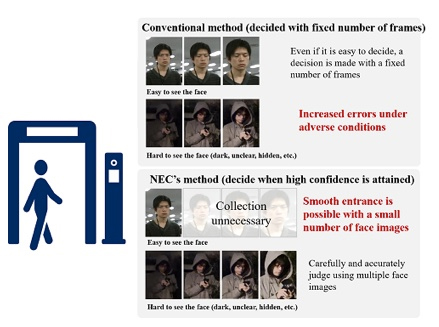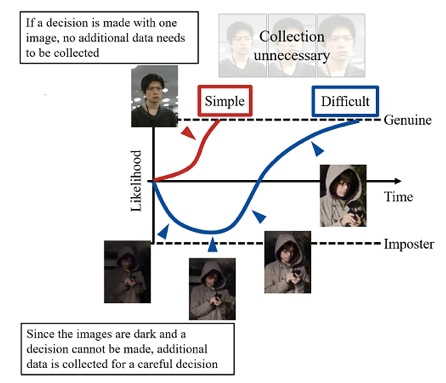NEC Corporation announced the development of artificial intelligence (AI) technology that makes high-speed decisions while maintaining high accuracy in real-time analysis of time series data. This technology is expected to enable face recognition as well as cyberattack detection and analysis to be accelerated by up to 20 times while maintaining the same accuracy as existing methods.

Typical AI engines for face recognition and cyberattacks depend on a preset amount of data to be collected before making a decision. For example, at entrance gates that utilize face recognition, individuals are authenticated by taking a previously fixed number of frames in succession, followed by a final decision.
NEC?s new technology collects and analyzes data without a previously fixed amount of data required. Inspired by neuroscience, the technology makes a decision as quickly and accurately as possible by accumulating evidence until a certain confidence level (likelihood) is reached. Since additional data collection is unnecessary after reaching the desired confidence level, computations can be accelerated when compared to conventional approaches.
The technology is based on brain activities during complex decisions which require sequential evidence accumulation. The Sequential Probability Ratio Test (SPRT) (1) that this technology is based on was first proposed in the 1940s and adopted for quality-control in the manufacturing field.
More recently, a neuroscience study revealed that neurons in the parietal lobe of the cerebellar cortex accumulate evidence during decision making, reminiscent of the SPRT. However, because of the SPRT?s strict prerequisites, it was difficult to deploy the SPRT under a wide range of real-world scenarios. With machine learning knowledge, NEC has devised the innovative “SPRT-based algorithm that Treat As Nth-Order Markov Series” (SPRT-TANDEM) to overcome the prerequisites and achieve both speed and accuracy.
NEC is applying this technology to the facial
recognition AI-engine “NeoFace” (2), which is at the core of NEC’s
portfolio of biometric identification technologies, “Bio-IDiom” (3),
featuring the world’s No. 1 authentication accuracy (4). In addition,
NEC will consider applying this technology to broader areas that utilize
time series data, including detecting and analyzing cyberattacks and
other unauthorized communications.




